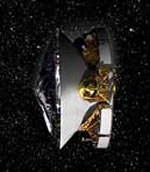
Image credit: NASA/JPL
Opportunity, NASA’s second Mars Exploration rover, has been in space for a few days now and everything seems to be going according to plan. The spacecraft has reduced its spin rate from 12 rotations a minute to just 2; enabling it to switch to celestial navigation using its star scanner. In fact, one of the first reference points Opportunity used was Mars – already one of the brightest objects in view. It’s already over 7 million kilometres away from the Earth and on track to arrive at Mars on January 25.
NASA’s Opportunity spacecraft, the second of twin Mars Exploration Rovers, has successfully reduced its spin rate as planned and switched to celestial navigation using a star scanner.
Prior to today?s maneuver, Opportunity was spinning 12.13 rotations per minute. Onboard thrusters were used to reduce the spin rate to approximately 2 rotations per minute, the designed rate for the cruise to Mars. After the spinning slowed, Opportunity’s star scanner found stars that are being used as reference points for spacecraft attitude. One of the bright points in the star scanner’s first field of view was Mars.
All systems on the spacecraft are in good health. As of 6 a.m. Pacific Daylight Time July 10, Opportunity will have traveled 6.6 million kilometers (4.1 million miles) since its July 7 launch. The Mars Exploration Rover flight team at NASA’s Jet Propulsion Laboratory, Pasadena, Calif., is preparing to command Opportunity’s first trajectory-correction maneuver, scheduled for July 18.
Opportunity will arrive at Mars on Jan. 25, 2004, Universal Time (evening of Jan. 24, 2004, Eastern and Pacific times). The rover will examine its landing area in Mars’ Meridiani Planum area for geological evidence about the history of water on Mars.
Opportunity’s twin, Spirit, also continues in good health on its cruise to Mars. As of 6 a.m. Pacific Daylight Time July 10, it will have traveled 82.6 million kilometers (51.3 million miles) since its June 10 launch.
JPL, a division of the California Institute of Technology, manages the Mars Exploration Rover project for NASA’s Office of Space Science, Washington, D.C. Additional information about the project is available from JPL at http://mars.jpl.nasa.gov/mer or and from Cornell University, Ithaca, N.Y., at http://athena.cornell.edu.
Original Source: NASA/JPL News Release
